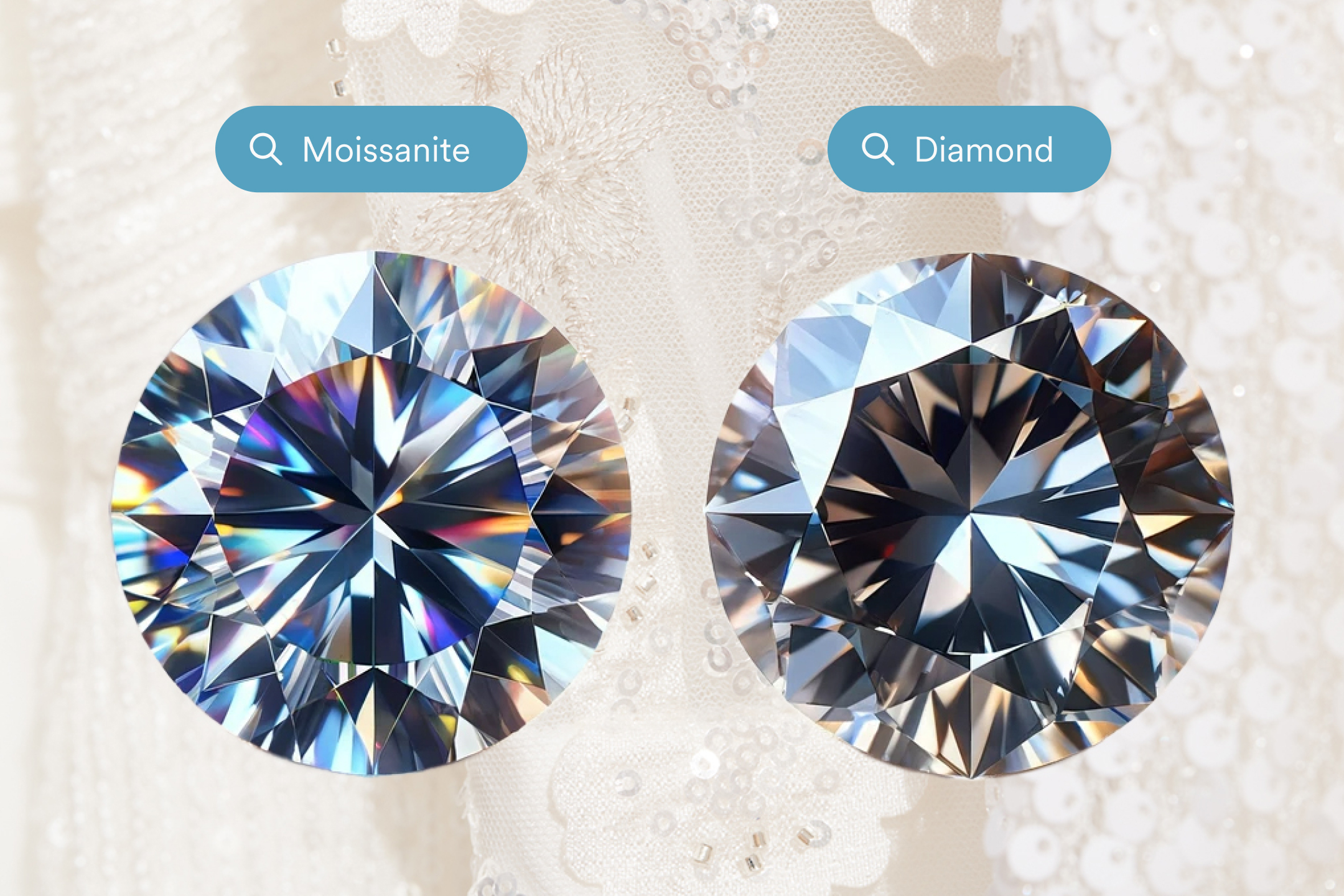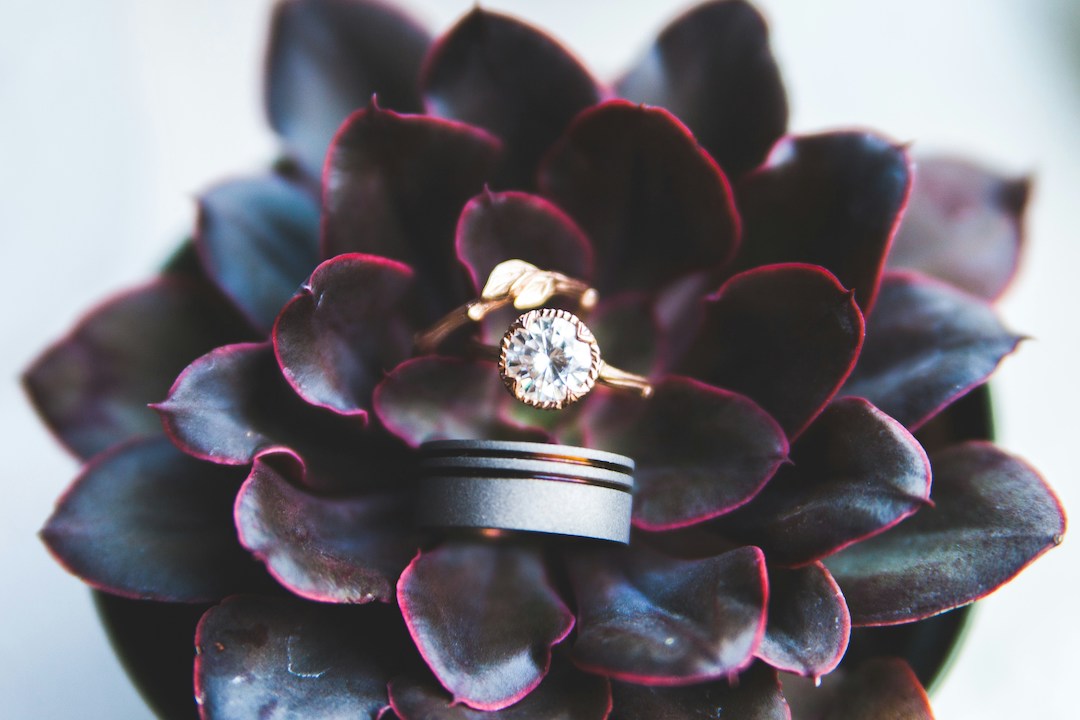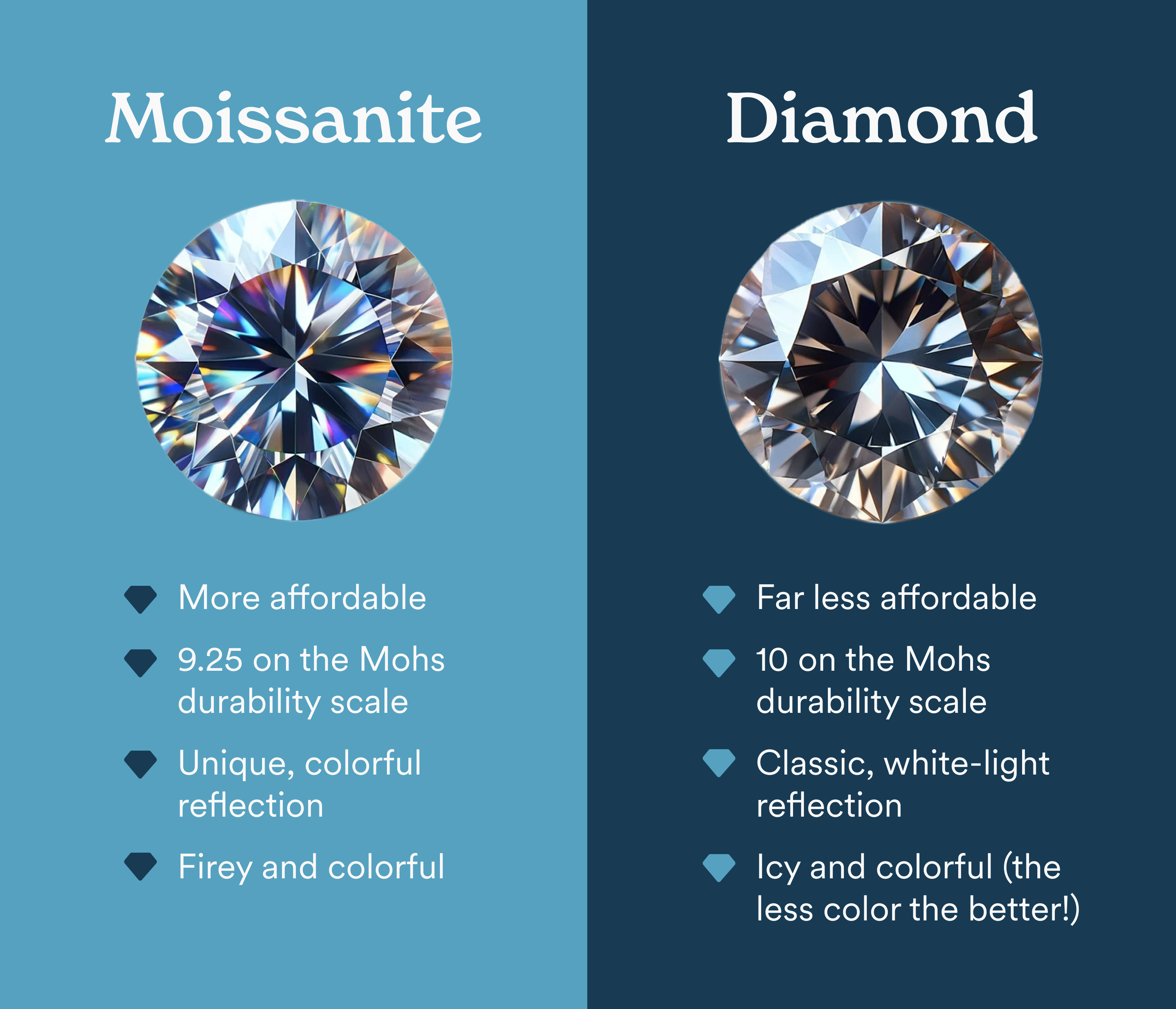- Expert advice/
- Getting engaged/
- Rings/
- Moissanite vs Diamond: Everything To Know
- Rings
Moissanite vs Diamond: Everything To Know
Learn the differences and similarities between moissanite and diamond so you can decide which sparkly rock is your best friend!
Last updated September 29, 2024

TLDR
- Moissanite is a natural occuring mineral that is similar to diamond, yet it doesn't have as much value.
- If you're looking for an ethical choice, moissanite is a good option, although diamonds are more responsibly sourced than they used to be.
- Talk to your partner to see what they value and if getting an alternative stone aligns with what they want to wear.
When choosing the perfect engagement ring, couples today have more options than ever before. While diamonds have long been the traditional choice, moissanite has emerged as a popular alternative that's capturing hearts and turning heads. 72% of Zola couples surveyed said that diamond alternatives and substitutes (lab-grown diamonds, moissanite, other gems, etc.) are most certainly ‘in’ right now.
But what exactly is moissanite, and how does it compare to the classic diamond? In this comprehensive guide, we'll explore the key differences between these two dazzling gemstones, helping you make an informed decision that aligns with your values, style, and budget.
What is moissanite?
Moissanite is the common name for silicon carbide, a naturally occurring mineral that was first discovered in 1893 by French scientist Henri Moissan. While examining rock samples from a meteor crater in Arizona, Moissan initially mistook the crystals for diamonds due to their brilliant sparkle. However, these crystals turned out to be a unique gemstone with properties that would make it a beloved choice for jewelry in the years to come.
Today, most moissanite used in jewelry is lab-created, ensuring consistent quality and ethical sourcing. This process of creation allows for the production of larger, clearer stones that rival the beauty of diamonds at a fraction of the cost. The result is a gemstone that offers exceptional brilliance, durability, and ethical appeal, making it an increasingly popular choice for engagement rings and other fine jewelry.

Key differences of moissanite vs. diamond
When comparing moissanite to diamonds, several key factors come into play.
Brilliance and fire
One of moissanite's most striking characteristics is its brilliance and fire, in other words, the way it sparkles and reflects light. In fact, moissanite often outshines diamonds in this aspect.
- Brilliance: Moissanite has a refractive index of 2.65-2.69, compared to a diamond's 2.42. This means moissanite bends light more effectively, resulting in a higher level of sparkle.
- Fire: The dispersion rate of moissanite (0.104) is more than twice that of a diamond (0.044), creating more colorful flashes of light, especially in sunlight.
Hardness and durability
While diamonds are renowned for their hardness, moissanite is also exceptionally durable. In fact, moissanite is an excellent choice for everyday wear, standing up well to the rigors of daily life almost as effectively as a diamond.
- Mohs Hardness Scale - moissanite 9.25, diamond 10
- Toughness - moissanite: excellent, diamond: good
- Resistance to scratching - moissanite: very high, diamond: highest
Color and clarity
Moissanite is available in a range of color grades, from colorless to near-colorless.
- Colorless moissanite is comparable to a D-F color diamond.
- Near-colorless moissanite may have a slight warmth, similar to G-I color diamonds.
- Some larger moissanite stones may exhibit a subtle color shift in certain lighting conditions, appearing slightly grayish or yellowish.
In terms of clarity, most moissanite used in jewelry is equivalent to VS (Very Slightly Included) or better on the diamond clarity scale, ensuring a clean appearance to the naked eye.

Ethical aspects
In today's world, consumers are considing how goods are aquired, with ethical sourcing ranking high. Moissanite offers several advantages in this area.
- Conflict-free sourcing: Lab-created moissanite avoids the ethical concerns associated with diamond mining, such as worker exploitation and environmental damage.
- Sustainable production: The creation of moissanite has a lower environmental impact compared to diamond mining.
- Affordability: Moissanite's lower cost allows couples to choose a larger or higher-quality stone without compromising their values or budget.
While the diamond industry has made strides in ethical sourcing through initiatives like the Kimberley Process, moissanite provides a guaranteed conflict-free option.
4 Tips for choosing moissanite vs. diamond for your engagement ring
Now that you’re a bit more familiar with the benefits of choosing a moissanite over a diamond, you ultimately need to make a decision before heading out.
1. Plan your budget.
One of the most significant advantages of moissanite is its affordability compared to diamonds. Moissanite offers an attractive option for couples looking to maximize their budget without compromising on sparkle. Let's break down the potential savings:
- 1 Carat Weight (savings of $4,400-$6,000) - diamonds are an average of $5,000-$7,000, and moissanite is an average of $600-$1,000
- 1.5 Carat Weight (savings of $9,000-$13,500) - diamonds are an average of $10,000-$15,000, and moissanite is an average of $1,000-$1,500
- 2 Carat Weight (savings of $18,500-$27,500) - diamonds are an average of $20,000-$30,000, and moissanite is an average of $1,500-$2,000
2. Select a ring style.
Both moissanite and diamonds offer a wide range of cuts, shapes, and settings to suit various personal styles. Consider these popular styles for both stones:
- Classic solitaire
- Halo setting
- Three-stone design
- Vintage-inspired settings
- Modern, minimalist designs
In short, any style you want for a traditional diamond ring, you can find in moissanite. The only exception may be vintage and estate rings, which are already set with diamonds. However, if you have your heart set on a preloved piece, you can always buy a vintage setting and have it set with a moissanite: It’s the best of both worlds!
3. Consider your personal values.
For many couples, the ethical considerations of their engagement ring are paramount. Moissanite's lab-created nature means it's inherently conflict-free and has a lower environmental impact compared to mined diamonds. If sustainability and ethical sourcing are important to you, moissanite aligns well with these values.
4. Understand what your partner wants.
Even if you’ve considered your budget, style, and sourcing, your partner may have their heart set on a diamond. The last thing you want to do is cause disappointment on such a happy occasion.
When budget is a concern, think about getting a smaller diamond instead of a larger one to help save money. If ethics and sustainability is a top factor, consider getting a lab-grown diamond or look at preowned rings at a pawn shop, in an antiques store, or in a jewelry store’s estate section.
How to find the perfect moissanite engagement ring
Once you've decided that moissanite is the right choice for you, the next step is finding the perfect ring. Here are some tips to guide your search:
- Understand moissanite grading: Unlike diamonds, moissanite isn't graded on the traditional 4Cs scale. Instead, focus on color grade and clarity.
- Color: Look for "colorless" or "near-colorless" grades for the best quality.
- Clarity: Choose "eye clean" or better for a flawless appearance.
- Choose the right size: Moissanite's intense brilliance makes it appear larger than a diamond of the same carat weight. To achieve a similar visual impact, consider going slightly smaller than you might with a diamond.
- Select a complementary setting: Opt for settings that enhance moissanite's unique properties. Prong settings maximize light reflection, while bezel settings offer a modern, secure option.
- Work with reputable retailers: Choose jewelers experienced in moissanite who can guide you through the selection process and ensure you're getting a high-quality stone.
- Consider customization: Many retailers offer customization options to create a unique ring that reflects your style.

FAQ about moissanite vs. diamond
Q: Will people be able to tell that my ring is moissanite instead of diamond? A: To the untrained eye, moissanite is nearly indistinguishable from diamond, especially in smaller sizes.
Q: How do I care for my moissanite ring? A: Use a soft brush if needed to clean your moissanite ring with mild soap and warm water. Avoid harsh chemicals and ultrasonic cleaners.
Q: Can I resize my moissanite ring? A: Yes, most moissanite rings can be resized, but it's best to consult with a jeweler experienced in working with moissanite.
Beyond choosing the perfect moissanite ring, many couples find themselves looking for answers in many areas, which is where Zola can help! In addition to our expert advice section filled with articles, we have wedding planning tools, such as our wedding budget calculators and guest list managers. Our wedding invitation templates help you customize designs for your big day, and—of course—our full selection of wedding websites is a great place to start.
- Expert advice/
- Getting engaged/
- Rings/
- Moissanite vs Diamond: Everything To Know
Find even more wedding ideas, inspo, tips, and tricks
We’ve got wedding planning advice on everything from save the dates to wedding cakes.
